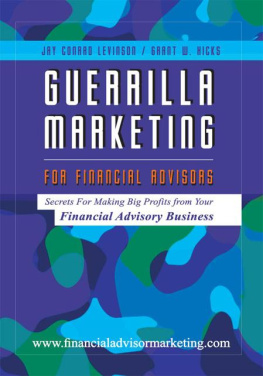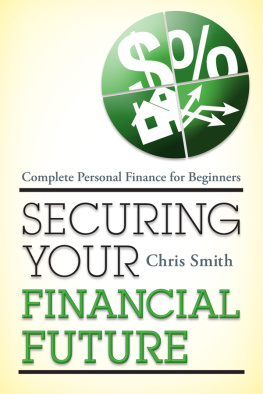Copyright 2016 by Liz Davidson
All rights reserved
This book presents the ideas of its author. It is not intended to be a substitute for consultation with a financial professional. The publisher and the author disclaim liability for any adverse effects resulting directly or indirectly from information contained in this book.
Please note that several of the names and personal details in the book have been changed in order to protect peoples identities.
For information about permission to reproduce selections from this book, write to or to Permissions, Houghton Mifflin Harcourt Publishing Company, 3 Park Avenue, 19th Floor, New York, New York 10016.
www.hmhco.com
The Library of Congress has cataloged the print edition as follows:
Davidson, Liz
What your financial advisor isnt telling you: the 10 essential truths you need to know about your money / Liz Davidson.
pages cm
ISBN 978-0-544-60230-4 (hardback)
ISBN 978-0-544-63334-6 (ebook)
1. Finance, Personal. I. Title.
HG 173. D 335 2016
332.024dc23
2015015902
Cover design by Brian Moore
v1.0116
The chart on . All other graphs and diagrams throughout the book are courtesy of the author, including the DebtBlaster chart, which was developed using software licensed from Highsoft AS, Norway.
For mom.
Your courage has been the greatest lesson of my life.
Authors Note
Before you read any further, please know this: I am not a financial advisor. I have zero investments, insurance, or mutual funds to sell you. I couldnt legally sell them to you even if you asked, because Im not licensed to sell securities. I dont have a pitch, an ulterior motive, or a quota to reach. And thats precisely why I am the author of this book.
As the founder and CEO of Financial Finesse, I run a company that provides people with entirely unbiased financial guidance, no strings attached, and this book is an extension of that practice. While the mission of this book is to shed light on the limitations of the financial advisor industry and to offer education, support, and insider knowledge that you are unlikely to receive in a typical advisor-client relationship, What Your Financial Advisor Isnt Telling You is not intendedin tone or in contentto be an expos of financial planners or the financial services industry as a whole.
Rather, the purpose of this book is to educate you about the vitally important questions you need to ask about your long-range financial future, whether or not you choose to have a financial advisor. Many millions of Americans put their faith and trust in their advisors, and thats fine. But you really owe it to yourself to know the right questions to ask your advisor. After all, if you cant have a truly open dialogue with your advisor about your money, you may never get on the same page. Furthermore, it is important to bear in mind that if you dont ask, your advisor is not always going to volunteer certain information.
As the employer of a team of elite CERTIFIED FINANCIAL PLANNER professionals who work exclusively as full-time financial educators, I know what a unique and valuable opportunity it is to work with exceptional financial planners. These professionals have the extensive training and experience to help people in all areas of their financial lives and a deep commitment to helping others become more financially secure.
The problem with financial advisors does not lie with them as people; the problem is that they work in an industry that is typically not incentivized to operate in the consumers best interest. Back when the CERTIFIED FINANCIAL PLANNER professionals at Financial Finesse were employed at large financial institutions, making a living by selling financial products and services, they were generally limited to working with people who could afford to purchase high-priced financial products and services. They entered the profession to help all people, but the current system didnt always make that financially feasible.
In todays financial services industry, those who most need serious financial help are the least likely to get it, and those who can afford it too often receive sales pitches rather than the unbiased guidance theyre looking for. As you will learn in the introduction to this book, this is what inspired me to open the doors of Financial Finesse in the first placethe strong belief and personal conviction that everyone is entitled to the benefits of unbiased financial education. By writing this book, my staff and I now have the opportunity on a broader scale to share financial knowledge that will better equip you to be in control of your money.
This book is being released at a time when the financial industry is moving toward more transparency, which is good news. The even better news is that this book is the tool that will help you capitalize on this new transparency.
Introduction
DAN AND MARGIES STORY
After Dan and Margie sold their mortgage-free home and moved to Florida, they were $500,000 richer in cash. While transferring their account from their branch in New York, the Florida-based bank teller suggested that they meet with the banks investment brokers, so they did. After discussions and an evaluation, the broker sold them a variable annuity, in which they invested about $350,000. The plan was for the annuity to generate lifetime income payments to pay for their regular monthly expenses in retirement.
What Dan and Margie didnt realize was that the variable annuity was invested primarily in stocks. When the market took a downturn, their annuity income did too. This meant that Dan and Margie would eventually have to start drawing down their retirement nest egg to supplement the dwindled annuity income in order to cover their regular monthly expenses. In an effort to protect their retirement income, they unintentionally put themselves at risk of running out of money with a product that was too aggressive for their needs.
REGINA AND MARCS STORY
Regina and Marc waited a long time to have a baby, and when they did they made three important phone calls: the first two went to their respective parents, and the third went to a financial advisor who had advertised on one of Reginas favorite baby websites. They didnt want to waste any time before setting up a college fund for their new bundle of joy.
Marc, a high school teacher at the most respected private school in the community, knew all too well the financial trouble that many families found themselves in when it was time to apply to college. As a teacher, Marc was passionate about the value of education and adamant that his son would not have to make compromises when it came to going to the college or university of his choice. He was determined to do whatever it took to make sure he and his wife saved enough to fully pay for his sons education.
Marc and Reginas financial advisor explained to them the benefits of a 529 plan: the tax savings, the prepaid option offered by some states, and the comfort of knowing that, when the time came, their son would be able to attend college without taking out student loans. The planner estimated that with a 7 percent increase in college costs per year, they would need to save about $240,000 by the time their son was 18 and going off to school. To reach that goal, the advisor recommended that Regina and Marc sock away close to $550 a month. The problem was that the advisor was only planning for what they specifically asked himhow to save for collegeand had asked no other questions.
The next month, when Regina went to pay her credit card bill online, she remembered that she had been planning to use that $550 a month to pay down her hefty $10,000 balance, which she had accrued before she met Marc; she had used her credit card to sustain herself when she was unexpectedly laid off from her job. Since that amount was now being allocated to the babys future, she clicked to pay the minimum monthly payment and her payment was satisfied for the billing cycle.
Next page















